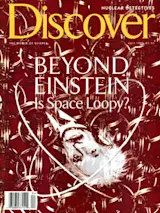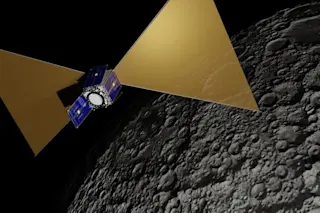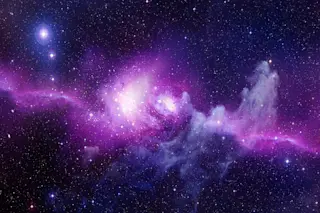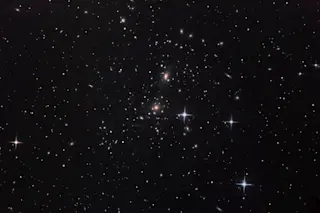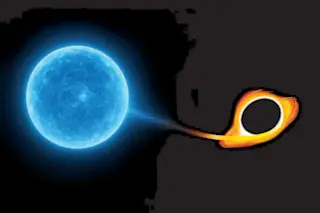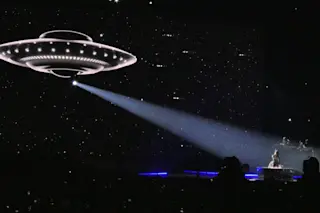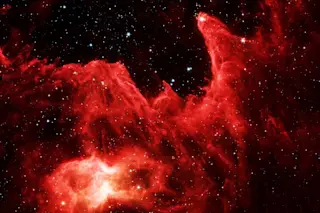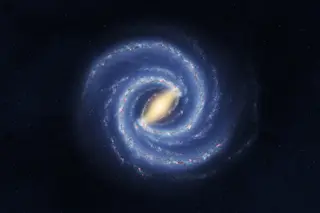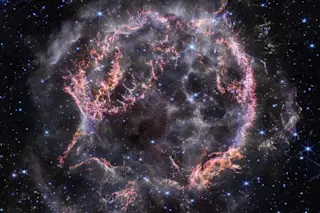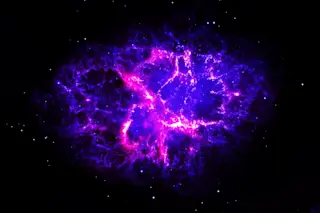If you believe William Tifft’s data, there are problems with the modern cosmos. For instance, maybe--repeat, maybe--it isn’t expanding.
William Tifft is 61 years old, has white hair, a decidedly unflamboyant style of talking, and no obvious penchant for self-promotion. His every outward manifestation, from the neat trim of his mustache to the sharp slant of his small handwriting, bespeaks a meticulous, methodical manner. He is devoted to his data. But the data that Tifft, an astronomer at the University of Arizona, has been collecting for nearly two decades now have the potential to take modern cosmology, from the Big Bang to dark matter, and cut it off at the knees. Tifft’s data--or as he stresses cautiously, one possible interpretation of his data--suggest that the universe might not be expanding.
The argument that pits Tifft against nearly all other astronomers and cosmologists concerns the phenomenon of redshift. The light reaching us from all but a few nearby galaxies is shifted toward the red end of the spectrum--that is, toward longer wavelengths and lower frequencies. For most of the century this redshift has been taken as a measure of the speed at which a galaxy is hurtling away from us--the assumption being that its light is redshifted for much the same reason that the pitch of an ambulance siren is lowered after it passes. What’s more, since 1929 there’s been an order to the recession of the galaxies, a simple relation discovered in that year by Edwin Hubble: the farther the galaxy, the greater its redshift. If redshift is an indicator of speed, that means galaxies are not just moving through space, because then there would be no reason for the farthest galaxies to be moving fastest. Instead, space itself must be expanding at a uniform rate, with more space popping up between things that are already widely separated.
Again, that is true if redshift is an indicator of recession speed--if it is caused by the stretching of a galaxy’s light waves by the expansion of space. But that is precisely the interpretation that Tifft is trying to complicate. If a galaxy’s light is redshifted only by the expansion of space (and its own smaller motion through space), the amount of redshift should depend on its distance and not on what type of galaxy it is. And the redshifts of all galaxies together should form a random distribution, reflecting the random distribution of distances at which galaxies are observed. Tifft’s observations over the past 20 years have convinced him that neither of these conditions applies to the real universe. Lately a few of his peers, but only a few, have come to share his conviction.
In the 1970s, while observing clusters of galaxies, Tifft first noted that redshift seemed to depend on the type of galaxy that was emitting the light. Spiral galaxies, for example, tended to have higher redshifts than elliptical galaxies in the same cluster. And dimmer galaxies tended to have higher redshifts than brighter ones.
Observing other clusters and pairs of equidistant galaxies, Tifft made an even more startling discovery. He found that his galactic redshifts took on only certain discrete values instead of being randomly distributed. In other words, redshifts appeared to increase by quantum leaps-- specifically, by a leap of 45 miles per second, if the redshift was interpreted in the conventional way as a galaxy’s velocity. Later Tifft modified his conclusion by saying that the redshifts of some types of galaxies were distributed at intervals of a third or a half of 45 miles per second. But the basic idea remained: galactic redshifts are quantized, like the energy states of an atom.
That idea has never gone over very well with most of Tifft’s peers. The editors of the Astrophysical Journal grudgingly published his first quantized-redshift paper in 1976, but they announced in an unusual disclaimer that they couldn’t endorse the idea (although they also couldn’t find anything wrong with the underlying observations). The reasons for their dislike are not hard to fathom. If the universe isn’t expanding, there would be no reason to believe it was ever compressed into a single point--no reason, that is, to believe it began with a Big Bang. If redshift isn’t a simple measure of velocity, then the argument that most of the universe is dark matter, which is based primarily on elaborate measurements of galactic velocities, would probably also fall apart. Cosmologists are generally loath to toss twentieth-century cosmology into the dustbin.
Tifft is careful to stress that he is proposing no such thing. He isn’t necessarily claiming that the universe isn’t expanding, he says--only that if it is, some other process is affecting redshifts as well. His basic idea is that redshift could be an intrinsic property of the galaxy and not merely something done to its light as the light travels through space. He thinks that some type of quantum mechanics may govern galaxies as it does atoms--that galaxies occupy various energy states, with a characteristic redshift corresponding to each one. But it is not at all clear what that means. Nor is it clear, in spite of Tifft’s disclaimer, how quantized redshifts would be compatible with an expanding universe.
More recently Tifft has also claimed to have evidence, from observing the same galaxies over a period of ten years, that their redshifts change over time. We may be seeing some form of galactic evolution taking place before our very eyes, he says. Galaxies, he argues, might evolve from high- to low-redshift states. Thus the farthest galaxies would exhibit the greatest redshift, not because they are flying away from us at nearly the speed of light but simply because in looking across vast distances we are looking backward in time to their high-energy infancy. Nearby galaxies, on the other hand, whose light reaches us more quickly, show their true age and a lower redshift.
That Tifft cannot explain why redshifts are quantized does not, of course, prove that they aren’t. There have been several attempts to refute his observations; in the most recent one, Bruce Guthrie and William Napier, working at the Royal Observatory in Edinburgh, measured the redshifts of 89 spiral galaxies--and surprised themselves by uncovering data that support the case for quantized redshifts. The redshifts they measured were spaced at intervals of about half of Tifft’s original quantum of 45 miles per second.
Tifft and his colleague John Cocke are planning another round of observations to demonstrate both that redshifts are quantized and that they vary over time. With a 328-foot radio telescope now scheduled to be built in Green Bank, West Virginia (it will replace one that collapsed there in 1988), they will measure the redshifts of more than 1,000 galaxies and compare the results with measurements made decades ago. But until then, at least, most astronomers are willing to let the universe go on expanding in the conventional way.


